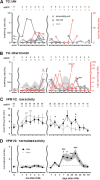Long-term changes in trigeminal ganglionic and thalamic neuronal activities following inferior alveolar nerve transection in behaving rats
- PMID: 23136441
- PMCID: PMC6621638
- DOI: 10.1523/JNEUROSCI.1828-12.2012
Long-term changes in trigeminal ganglionic and thalamic neuronal activities following inferior alveolar nerve transection in behaving rats
Abstract
The transection of the inferior alveolar nerve (IANx) produces allodynia in the whisker pad (V2 division) of rats. Ectopic discharges from injured trigeminal ganglion (TG) neurons and thalamocortical reorganization are possible contributors to the sensitization of uninjured V2 primary and CNS neurons. To test which factor is more important, TG and ventroposterior medial nucleus (VPM) neurons were longitudinally followed before, during, and after IANx for up to 80 d. Spontaneous discharges and mechanical stimulation-evoked responses were recorded in conscious and in anesthetized states. Results show (1) a sequential increase in spontaneous activities, first in the injured TG neurons of the IAN (2-30 d), followed by uninjured V2 ganglion neurons (6-30 d), and then VPM V2 neurons (7-30 d) after IANx; (2) ectopic discharges included burst and regular firing patterns in the IAN and V2 branches of the TG neurons; and (3) the receptive field expanded, the modality shifted, and long-lasting after-discharges occurred only in VPM V2 neurons. All of these changes appeared in the late or maintenance phase (7-30 d) and disappeared during the recovery phase (40-60 d). These observations suggest that ectopic barrages in the injured IAN contribute more to the development of sensitization, whereas the modality shift and evoked after-discharges in the VPM thalamic neurons contribute more to the maintenance phase of allodynia by redirecting tactile information to the cortex as nociceptive.
Figures











Similar articles
-
Macrophages in trigeminal ganglion contribute to ectopic mechanical hypersensitivity following inferior alveolar nerve injury in rats.J Neuroinflammation. 2017 Dec 16;14(1):249. doi: 10.1186/s12974-017-1022-3. J Neuroinflammation. 2017. PMID: 29246259 Free PMC article.
-
Nitric oxide signaling contributes to ectopic orofacial neuropathic pain.J Dent Res. 2013 Dec;92(12):1113-7. doi: 10.1177/0022034513509280. Epub 2013 Oct 15. J Dent Res. 2013. PMID: 24130220
-
Induction of Fos protein-like immunoreactivity in the trigeminal spinal nucleus caudalis and upper cervical cord following noxious and non-noxious mechanical stimulation of the whisker pad of the rat with an inferior alveolar nerve transection.Pain. 2002 Feb;95(3):225-238. doi: 10.1016/S0304-3959(01)00403-1. Pain. 2002. PMID: 11839422
-
Involvement of medullary GABAergic system in extraterritorial neuropathic pain mechanisms associated with inferior alveolar nerve transection.Exp Neurol. 2015 May;267:42-52. doi: 10.1016/j.expneurol.2015.02.030. Epub 2015 Feb 28. Exp Neurol. 2015. PMID: 25736265
-
Recent advances in basic research on the trigeminal ganglion.J Physiol Sci. 2016 Sep;66(5):381-6. doi: 10.1007/s12576-016-0448-1. Epub 2016 Mar 29. J Physiol Sci. 2016. PMID: 27023716 Free PMC article. Review.
Cited by
-
Electrophysiological characterization of a CaV3.1 calcium channel mutation linked to trigeminal neuralgia.Pflugers Arch. 2023 Jun;475(6):711-718. doi: 10.1007/s00424-023-02808-w. Epub 2023 Apr 3. Pflugers Arch. 2023. PMID: 37010626
-
Presynaptic Enhancement of Transmission from Nociceptors Expressing Nav1.8 onto Lamina-I Spinothalamic Tract Neurons by Spared Nerve Injury in Mice.eNeuro. 2024 Sep 10;11(9):ENEURO.0087-24.2024. doi: 10.1523/ENEURO.0087-24.2024. Print 2024 Sep. eNeuro. 2024. PMID: 39256039 Free PMC article.
-
Pathological Mechanisms and Therapeutic Targets for Trigeminal Neuropathic Pain.Medicines (Basel). 2019 Aug 22;6(3):91. doi: 10.3390/medicines6030091. Medicines (Basel). 2019. PMID: 31443547 Free PMC article. Review.
-
A multimodal meta-analysis of gray matter alterations in trigeminal neuralgia.Front Neurol. 2023 Aug 3;14:1179896. doi: 10.3389/fneur.2023.1179896. eCollection 2023. Front Neurol. 2023. PMID: 37602249 Free PMC article. Review.
-
Topiramate inhibits adjuvant-induced chronic orofacial inflammatory allodynia in the rat.Front Pharmacol. 2024 Aug 16;15:1461355. doi: 10.3389/fphar.2024.1461355. eCollection 2024. Front Pharmacol. 2024. PMID: 39221150 Free PMC article.
References
-
- Adrian ED. The effects of injury on mammalian nerve fibres. Proc Roy Soc Ser B. 1930;106:596–618.
-
- Barbay S, Peden EK, Falchook G, Nudo RJ. Sensitivity of neurons in somatosensory cortex (S1) to cutaneous stimulation of the hindlimb immediately following a sciatic nerve crush. Somatosens Mot Res. 1999;16:103–114. - PubMed
-
- Baron R. Mechanisms of disease: neuropathic pain—a clinical perspective. Nat Clin Pract Neurol. 2006;2:95–106. - PubMed
Publication types
MeSH terms
LinkOut - more resources
Full Text Sources
Miscellaneous
